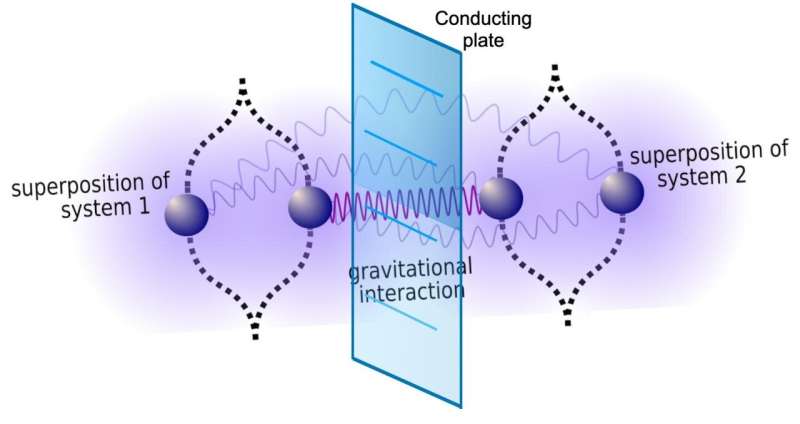In the proposed experiment, two diamonds are each placed in superposition and studied in freefall. Apart from gravity, the Casimir effect also draws them together, causing noise in the experiment. A thin copper plate can shield this effect, reducing the noise and making the experiment more manageable. Credit: A. Mazumdar, University of Groningen
Is gravity a quantum phenomenon? That has been one of the big outstanding questions in physics for decades. Together with colleagues from the UK, Anupam Mazumdar, a physicist from the University of Groningen, proposed an experiment that could settle the issue. However, it requires studying two very large entangled quantum systems in freefall. In a new paper, which has a third-year Bachelor's student as the first author, Mazumdar presents a way to reduce background noise to make this experiment more manageable.
Three of the four fundamental forces in physics can be described in terms of quantum theory. This is not the case for the fourth force (gravity), which is described by Einstein's theory of general relativity. The experiment that Mazumdar and his colleagues previously designed could prove or disprove the quantum nature of gravity.
Superposition
A well-known consequence of the quantum theory is the phenomenon called quantum superposition: in certain situations, quantum states can have two different values at the same time. Take an electron that is irradiated with laser light. Quantum theory says that it can either absorb or not absorb the photon energy from the light. Absorbing the energy would alter the electron's spin, a magnetic moment that can be either up or down. The result of quantum superposition is that the spin is both up and down.
These quantum effects take place in tiny objects, such as electrons. By targeting an electron in a specially constructed miniature diamond, it is possible to create superposition in a much larger object. The diamond is small enough to sustain this superposition, but also large enough to feel the pull of gravity. This characteristic is what the experiment exploits: placing two of these diamonds next to each other in freefall and, therefore, canceling out external gravity. This means that they only interact through the gravity between them.
Challenging
And that is where another quantum phenomenon comes in. Quantum entanglement means that when two or more particles are generated in close proximity, their quantum states are linked. In the case of the diamonds, if one is spin up, the other, entangled diamond should be spin down. So, the experiment is designed to determine whether quantum entanglement occurs in the pair during freefall, when the force of the gravity between the diamonds is the only way that they interact.
"However, this experiment is very challenging," explains Mazumdar. When two objects are very close together, another possible mechanism for interaction is present, the Casimir effect. In a vacuum, two objects can attract each other through this effect. "The size of the effect is relatively large and to overcome the noise it creates, we would have to use relatively large diamonds." It was clear from the outset that this noise should be reduced to make the experiment more manageable. Therefore, Mazumdar wanted to know if shielding for the Casimir effect was possible.
Lockdown
He handed the problem to Thomas van de Kamp, a third-year Bachelor's student of Physics. "He came to me because he was interested in quantum gravity and wanted to do a research project for his Bachelor's thesis," says Mazumdar. During the spring lockdown, when most normal classes were suspended, Van de Kamp started working on the problem. "Within a remarkably short time, he presented his solution, which is described in our paper."
This solution is based on placing a conducting plate of copper, around one millimeter thick, between the two diamonds. The plate shields the Casimir potential between them. Without the plate, this potential would draw the diamonds closer to each other. But with the plate, the diamonds are no longer attracted to each other, but to the plate between them. Mazumdar: "This removes the interaction between the diamonds through the Casimir effect, and therefore removes a lot of noise from the experiment."
Remarkable
The calculations performed by Van de Kamp show that the masses of the two diamonds can be reduced by two orders of magnitude. "It may seem like a small step, but it does make the experiment less demanding." Furthermore, other parameters such as the level of vacuum needed during the experiment also become less demanding due to the shielding of the Casimir effect. Mazumdar says that a further update on the experiment, which also includes a contribution from Bachelor's student Thomas van de Kamp, will probably appear in the near future. "So, his six-month project has brought him co-authorship on two papers, quite a remarkable feat."
More information: Thomas W. van de Kamp et al, Quantum gravity witness via entanglement of masses: Casimir screening, Physical Review A (2020). DOI: 10.1103/PhysRevA.102.062807
Journal information: Physical Review A
Provided by University of Groningen
























